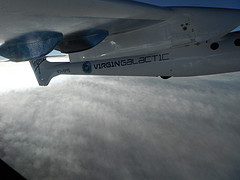Private spaceflight, an industry built on the dream of taking adventurers and scientists aloft, suffered a setback after two accidents in four days highlighted the perils of rocket power.
As investigators yesterday began studying a fatal test flight by Richard Branson’s Virgin Galactic Ltd., manufacturers and regulators are assessing possible fallout on his plans for suborbital tourism and the U.S. government’s decision to deploy commercial space taxis to fly into orbit later this decade.
“This really focuses the mind on what it means when there are people on board these launch vehicles,” said Loren Thompson, an aerospace industry analyst and consultant to Lockheed Martin Corp. “It almost inevitably means that government program managers will be more careful and more conservative, which signals a slow approach to utilizing this technology.”
The close-knit space business was already reeling from the failure of an unmanned Orbital Sciences Corp. rocket on Oct. 28. Then Branson’s SpaceShipTwo was lost on Oct. 31 over California’s Mojave Desert, with one pilot killed and another injured.
“While not a NASA mission, the pain of this tragedy will be felt by all the men and women who have devoted their lives to exploration,” Charles Bolden, administrator of the National Aeronautics and Space Administration, said in a statement. “Spaceflight is incredibly difficult, and we commend the passion of all in the space community who take on risk to push the boundaries of human achievement.”
Contract Glee
Little more than a month ago, Bolden and NASA struck a note of triumph in awarding as much as $6.8 billion in contracts to Boeing Co. and Elon Musk’s Space Exploration Technologies Corp. to ferry astronauts to the International Space Station.
Now the emerging business of private spaceflight faces another investigation into what went wrong. The U.S. National Transportation Safety Board is leading the inquiry with support from the Federal Aviation Administration, which licenses commercial space operations.
NTSB Chairman Chris Hart and a team of investigators began their work in California yesterday. After holding a short press conference, they were to begin reviewing flight data, interviewing witnesses and searching the desert where pieces of the craft landed.
Celebrity Clients
Virgin Galactic had targeted a 2015 debut for commercial tourism flights with SpaceShipTwo, an enterprise that had attracted celebrity clients from physicist Stephen Hawking to singer Sarah Brightman. Branson said last month that almost 800 would-be space tourists had signed up for the $250,000 trips.
A subdued Branson spoke yesterday at the NTSB press conference in California’s Mojave Desert.
“We are going to learn from what went wrong, discover how we can improve safety and performance, and then move forward together,” he said.
The accident could mean a three- to five-year setback to Virgin Galactic’s schedule for transporting passengers above the Earth’s atmosphere, said Michael Blades, an aerospace and defense analyst with Frost & Sullivan, a New York-based market research firm. The company will have to learn what went wrong, then show regulators via testing that won’t be repeated.
Branson said yesterday that he had received e-mails from would-be passengers urging him to forge ahead. He offered refunds and said he expects to lose “one or two” customers.
Billionaire Buzz
Branson’s involvement highlighted one of the shifts in the dawning of the second U.S. space age. Instead of being driven by NASA and shadowed by Cold War competition with the Soviet Union, spaceflight generates a buzz because of the involvement of billionaires such as Branson, Musk, Paul Allen and Jeff Bezos.
Shifting responsibility away from NASA refocuses attention on one of the drawbacks of the government’s decision to give entities beholden to investors a greater role in orbital and suborbital flight, said Marco Caceres, director of space studies at Fairfax, Virginia-based consultant Teal Group.
“The tendency is do a couple of test flights, then get into operation,” Caceres said. “That’s the biggest danger of this new era, where you have shareholder-backed companies making decisions. The danger is moving too quickly into operations before you’ve flown it nearly enough.”
Fuel Mixture
The Virgin Galactic flight marked the fourth under power for the rocket engine, which was “thoroughly tested” on the ground and had been through a qualification series, said Kevin Mickey, president of SpaceShipTwo’s manufacturer, Scaled Composites. The fuel mixture was new, he said.
“This was a new fuel formulation again that had been proven and tested on the ground many times,” Mickey told reporters at an Oct. 31 briefing.
Over time, the test accident probably won’t deter Virgin Galactic customers because the dream of traveling to space is too strong for some wealthy pioneers, Frost & Sullivan’s Blades said in a telephone interview.
“Rich people who want to do that are still going to want to go to space,” he said. “It’s just going to take a little bit more time for the reliability to be established.”

Photos by Scott Glaser
The challenge is that in trying to create a space-tourism industry, Virgin Galactic is pulling together a host of new systems – from its WhiteKnightTwo mother ship to SpaceShipTwo’s engine – just as NASA experimented with different rockets and capsules a half-century ago. Accidents can’t be ruled out, Blades said.
“It’s unfortunate but not unexpected, because you’re talking about new technology,” Blades said.
(With assistance from James Nash in Los Angeles and Alan Levin in Washington.)
Was this article valuable?
Here are more articles you may enjoy.

 Wells Fargo Sued by Ex-Manager Who Said Bank Faked Diversity
Wells Fargo Sued by Ex-Manager Who Said Bank Faked Diversity  Twice Injured Firefighter Loses Second Workers’ Compensation Claim
Twice Injured Firefighter Loses Second Workers’ Compensation Claim  LA Fires Push Insurers’ 2025 Disaster Losses to $107 Billion
LA Fires Push Insurers’ 2025 Disaster Losses to $107 Billion  Trump Sues BBC for $10 Billion Over Documentary Edit
Trump Sues BBC for $10 Billion Over Documentary Edit 